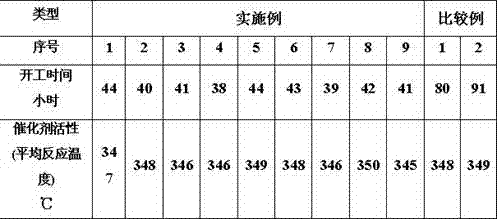Hydrocracking startup method
A technology for hydrocracking and starting oil, applied in chemical instruments and methods, through aromatics hydrorefining, petroleum industry and other directions, can solve the problems of catalyst activity, poor inert gas passivation effect, harm and other problems, and achieve accelerated initial activity. The effect of stable process, improved catalyst activity and simple process flow
- Summary
- Abstract
- Description
- Claims
- Application Information
AI Technical Summary
Problems solved by technology
Method used
Image
Examples
Embodiment 1
[0037] Firstly, low nitrogen start-up oil, hydrogen and vulcanizing agent are introduced into the hydrocracking unit, and then the hydrocracking catalyst is subjected to constant temperature vulcanization under the condition of 220°C. 4% of the theoretical dosage, after the hydrogen sulfide content in the circulating hydrogen reaches 4000ppm, reduce the adding rate of the sulfurizing agent to 1% of the theoretical dosage of the sulfurizing agent per hour and increase the bed temperature of the hydrocracking catalyst to 320°C, the time used is 15h, When the bed temperature of the hydrocracking catalyst reaches 320°C, increase the addition rate of the vulcanizing agent to 3% of the theoretical amount of vulcanizing agent per hour, continue the constant temperature vulcanization for 3 hours, then raise the temperature to 345°C and feed the raw material oil for reaction, wherein the The hydrocracking catalyst contains 5% nitrogen element, 5% nickel oxide, 16% molybdenum oxide and 5...
Embodiment 2
[0039] Firstly, low nitrogen start-up oil, hydrogen and vulcanizing agent are introduced into the hydrocracking unit, and then the hydrocracking catalyst is vulcanized at a constant temperature at 230°C. 5% of the theoretical dosage, after the hydrogen sulfide content in the circulating hydrogen reaches 5000ppm, reduce the adding rate of the sulfurizing agent to 1.5% of the theoretical dosage of the sulfurizing agent per hour and increase the bed temperature of the hydrocracking catalyst to 325°C, and the time used is 13h. When the bed temperature of the hydrocracking catalyst reaches 325°C, increase the adding rate of the vulcanizing agent to 4% of the theoretical amount of the vulcanizing agent per hour, continue the constant temperature vulcanization for 2 hours, then raise the temperature to 345°C and feed the raw material oil for reaction, wherein the The hydrocracking catalyst contains 5% nitrogen element, 5% nickel oxide, 16% molybdenum oxide and 55% Y-type molecular sie...
Embodiment 3
[0041] Firstly, low-nitrogen start-up oil, hydrogen and vulcanizing agent are introduced into the hydrocracking unit, and then the hydrocracking catalyst is subjected to constant temperature vulcanization under the condition of 240°C. 3% of the theoretical amount, after the hydrogen sulfide content in the circulating hydrogen reaches 3000ppm, reduce the addition rate of the sulfide agent to 0.8% of the theoretical amount of the sulfide agent per hour and increase the bed temperature of the hydrocracking catalyst to 330°C, and the time used is 10h. When the bed temperature of the hydrocracking catalyst reaches 330°C, increase the addition rate of the vulcanizing agent to 3% of the theoretical amount of vulcanizing agent per hour, continue constant temperature vulcanization for 4 hours, then raise the temperature to 340°C and feed the raw material oil for reaction, wherein the The hydrocracking catalyst contains 4% nitrogen element, 5% nickel oxide, 16% molybdenum oxide and 55% Y...
PUM
 Login to View More
Login to View More Abstract
Description
Claims
Application Information
 Login to View More
Login to View More - R&D
- Intellectual Property
- Life Sciences
- Materials
- Tech Scout
- Unparalleled Data Quality
- Higher Quality Content
- 60% Fewer Hallucinations
Browse by: Latest US Patents, China's latest patents, Technical Efficacy Thesaurus, Application Domain, Technology Topic, Popular Technical Reports.
© 2025 PatSnap. All rights reserved.Legal|Privacy policy|Modern Slavery Act Transparency Statement|Sitemap|About US| Contact US: help@patsnap.com


